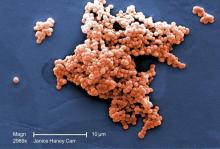No major shifts appear to have occurred in the bacteria that cause meningitis in Canada, said Lynda Ouchenir, MD, University of Montreal, and her associates.
“There is a paucity of information on the characteristics of neonatal meningitis in the era of infant Haemophilus influenzae type B (Hib) and pneumococcal immunization, maternal group B Streptococcus (GBS) prophylaxis, and emerging antimicrobial resistance,” the researchers said. So, they undertook a retrospective study of infants with onset of bacterial meningitis in the first 90 days of life at seven Canadian hospitals to find out the major pathogens involved and best empirical antibiotics to use.
They looked at 63 cases of proven bacterial meningitis and 50 of suspected bacterial meningitis that were identified in 61 boys and 52 girls with a median age of diagnosis of 19 days. Escherichia coli (33%) and GBS (31%) each accounted for approximately one-third of the cases of bacterial meningitis within the first 90 days of life. The typical empirical antibiotics used for meningitis presenting in days 0-6 included ampicillin for at least the first month and a third-generation cephalosporin. For meningitis presenting later in the 90 days, some cases of meningitis were not susceptible to those antibiotics, so a carbapenem was prescribed.This substitution of a carbapenem for the cephalosporin was considered prudent if the birth hospitalization was complicated and if the cerebrospinal fluid Gram-stain or the blood culture was suggestive of Gram-negative meningitis, Dr. Ouchenir and her associates said.
Read more at (Pediatrics. 2017;140[1)]:e20170476).


